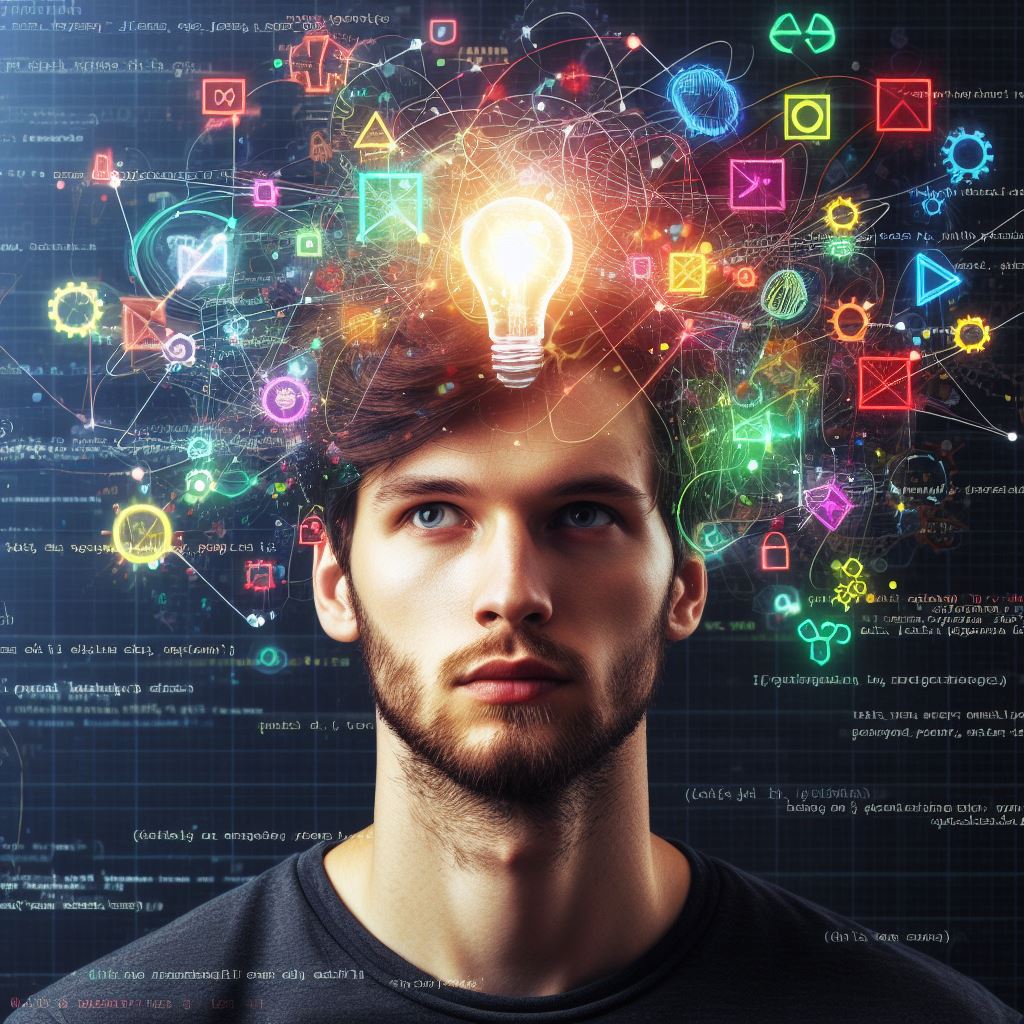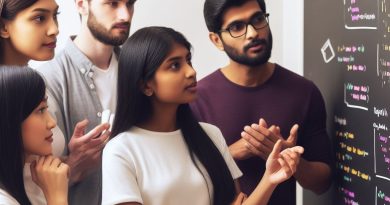Coding in Art: When Programming Meets Meaning
Last Updated on January 27, 2024
Introduction
Coding is the process of creating instructions for computers using a programming language.
It plays a significant role in our modern digital world. This article we will discuss Coding in Art
In this section, we will explore the intriguing intersection of coding and art.
Artistic expression has always been a way to convey meaning and evoke emotions.
However, with the advent of digital technology, artists have been able to integrate coding into their creative processes.
This fusion of programming and art has opened up a whole new world of possibilities.
By harnessing the power of code, artists can create interactive and dynamic artworks that engage the audience on multiple levels.
Through coding, they can manipulate visuals, sound, and even physical objects.
Furthermore, it allows artists to explore complex concepts and express deeper meanings.
The combination of technology and artistic vision enables them to push boundaries and challenge traditional notions of art.
We will delve into various examples of coding in art, from interactive installations to generative artworks.
We will also explore the impact of coding on the art world and how it has transformed the creative process.
By examining the intersection of coding and art, we can gain a deeper understanding of the potential of technology in artistic expression.
Join us as we embark on this exciting exploration of the fusion of coding and meaning in art.
Connecting Art and Coding
Definition of art coding and its purpose
Art coding refers to the practice of using programming languages and algorithms to create artistic pieces and interactive installations.
It is the fusion of technology and artistic expression, allowing artists to push boundaries and explore new creative possibilities.
The purpose of it is to break traditional artistic boundaries and create dynamic artworks that interact with the audience.
By utilizing code, artists can generate visuals, sounds, and even movements that would be impossible to achieve through traditional media.
It allows artists to experiment, innovate, and tell stories in unique and engaging ways.
Historical background of coding in art
The concept of coding in art can be traced back to the early days of computational art, which emerged in the 1960s.
Artists such as Vera Molnar and Manfred Mohr started using computers to create geometric and algorithmic artworks.
They employed coding techniques to generate complex patterns and shapes, exploring the intersection of art and mathematics.
In the 1980s, the advent of personal computers brought it to a wider audience.
Artists began experimenting with programming languages like BASIC and Pascal to create interactive installations and digital artworks.
The demoscene, a subculture focused on creating real-time audiovisual presentations, also emerged during this time, showcasing the artistic potential of coding.
With the rise of the internet and advancements in technology, it has also become more accessible and diverse.
Artists now have access to a wide range of programming languages and tools, allowing them to create interactive installations, generative art, and virtual reality experiences.
Examples of notable art pieces utilizing coding
- The Clock” by Christian Marclay: “The Clock” is an art piece created by Christian Marclay that compiles thousands of film clips depicting clocks and watches. The installation uses coding to synchronize the clips with the real-time, creating a 24-hour long film.
- “Hello World!” by Rafael Lozano-Hemmer: “Hello World!” is an interactive installation by Rafael Lozano-Hemmer that invites viewers to input text messages that are then transformed into light patterns on a massive LED display. The coding behind the installation enables real-time communication and engagement.
- “DevArt” by Various Artists: “DevArt” is a Google project that showcases artworks created using code. It features artists such as Zach Lieberman and Karsten Schmidt, who push the boundaries of art and technology through coding. The artworks range from interactive installations to immersive experiences.
- “Rain Room” by Random International: “Rain Room” is an immersive installation that utilizes sensors and coding to create a responsive environment. As viewers walk through the room, rainwater stops falling above them, creating a mesmerizing experience where they can interact with the rain without getting wet.
- “Mondrian Machine” by Jonathan Puckey: “Mondrian Machine” is a web-based application that allows users to create their own Mondrian-inspired artworks online. The coding behind the application generates the iconic grid patterns and colors associated with Piet Mondrian’s abstract compositions.
Lastly, It is a powerful tool that allows artists to transcend traditional artistic mediums and create interactive and dynamic artworks.
By embracing technology and programming languages, artists can push the boundaries of creativity and engage viewers in new and exciting ways.
The historical background and notable examples of art pieces utilizing coding showcase the immense potential of this art form in bridging the gap between programming and meaning.
Read: Bioinformatics with R: Processing Genomic Data
The Intersection of Programming and Artistic Expression
How artists use coding as a medium for self-expression
- Coding empowers artists to transcend traditional artistic boundaries and express their ideas.
- Artists can use coding to dynamically generate visual or auditory elements.
- Coding provides artists with a tool to create interactive and immersive experiences.
- Through coding, artists can explore new forms of expression and challenge societal norms
- Coding allows artists to incorporate real-time data and engage with the audience in unique ways.
The unique possibilities of coding in creating art
- Coding enables artists to create generative art that evolves over time.
- Artists can use algorithms to create complex patterns, simulations, and algorithmic compositions.
- Coding opens up possibilities for creating interactive installations and responsive environments.
- Artists can experiment with data visualization, translating complex data into visual representations.
- Coding allows artists to merge art with technology, creating digital or multimedia artworks.
Advantages and challenges of incorporating coding in art
1. Advantages
Coding provides artist with a new set tools and techniques for creative expression.
Coding introduces artists to problem-solving skills and a technological understanding.
2. Challenges
Artists need to acquire technical skills and knowledge to effectively use coding as a medium.
Ensuring the artwork remains accessible and engaging for non-technical audience members.
Artists must balance the creative and technical aspects, finding the right equilibrium.
Compatibility issues may arise due to different hardware or software systems.
Coding requires continuous learning and staying up-to-date with programming languages and framework
Read: Guide to Coding Certification for Absolute Beginners
Coding as a Tool for Visualization and Interactive Art
Forms of visual art enhanced by coding techniques
- Coding allows artists to create dynamic and interactive visual art pieces.
- Through coding, artists can add movement, animation, and changing patterns to their artwork.
- Code can be used to create generative art, where the art is continuously evolving and changing.
- Visual art created through coding techniques can also be immersive, taking viewers on a virtual journey.
- Coding enables artists to manipulate imagery and create visual effects that would not be possible with traditional art techniques.
Case studies of art installations that rely on coding for interactivity
- The Rain Room, a popular art installation, uses coding to create an interactive experience.
- In the Rain Room, sensors detect the presence of visitors and adjust the rainfall accordingly.
- Another example is the interactive light installation at the Color Factory exhibit.
- The light installation changes color and intensity based on the movement of the audience.
- These art installations demonstrate how coding can enable real-time interaction between the artwork and the audience.
The impact of coding on audience engagement and participation
- It makes the audience an active participant, rather than just passive viewers.
- Interactive art installations created using coding techniques invite viewers to engage and interact with the artwork.
- It allows the audience to have a unique and personalized experience, making the art more memorable.
- The use of coding in art can also create a sense of community and collaboration among the audience.
- Audience members can engage with the artwork and each other through shared experiences and discussions.
It can create more engaging and inclusive digital environments.
This, in turn, fosters greater participation and interaction with digital content and platforms.
Read: Web Scraping in R: How to Get Data from Websites

Influence of Coding on Different Art Forms
Art and technology have always had a symbiotic relationship.
As coding becomes more prevalent in our society, it is not surprising to see its influence spreading into various art forms.
Coding’s role in music composition and generation
Essentially, Coding has opened up new possibilities and expanded the creativity of musicians and composers.
- Algorithmic composition: With coding, composers can create complex algorithms that generate music, pushing the boundaries of traditional composition techniques.
- Live coding performances: Musicians can now code and perform simultaneously, creating dynamic and interactive music experiences.
- Sound design: Coding allows for precise manipulation and synthesis of sounds, enabling musicians to create unique and immersive sonic landscapes.
Coding in film and animation: pushing visual boundaries
Coding has revolutionized the world of film and animation, pushing the boundaries of visual storytelling.
- Visual effects: Coding has enabled the creation of stunning and realistic visual effects, enhancing the viewing experience of movies.
- Procedural generation: By using code, animators and filmmakers can generate vast and intricate worlds, reducing the manual labor traditionally required.
- Interactive storytelling: Coding has allowed filmmakers to create interactive narratives, giving audiences the power to shape the story through their choices.
Coding’s influence on digital and interactive storytelling
- Interactive installations: Artists can use coding to create immersive and interactive installations, blurring the lines between the physical and digital worlds.
- Augmented reality (AR) and virtual reality (VR): Coding plays a crucial role in developing AR and VR experiences, transforming the way stories are told and experienced.
- Gamification of storytelling: By integrating coding into storytelling, creators can develop engaging and interactive games that allow players to become part of the narrative.
- Data-driven narratives: Coding allows for the analysis and interpretation of vast amounts of data, influencing the creation of narratives based on real-world information.
As coding continues to evolve, it will undoubtedly have a more significant impact on different art forms.
Coding has become an integral part of various art forms, pushing the boundaries of creativity and enabling artists to explore new possibilities.
Whether it is in music composition, film, animation, or interactive storytelling, coding has revolutionized the way we create and experience art.
As technology continues to advance, the influence of coding on art will only continue to grow, opening up endless opportunities for innovation and expression.
Read: Online vs. In-Person: Which Coding Certification to Pick?
Ethical Considerations in Coding Art
In the rapidly evolving field of coding art, the intersection of programming and meaning raises important ethical considerations.
As artists increasingly incorporate coding into their artistic practices, it becomes crucial to critically examine the potential ethical issues that may arise.
Examining Potential Ethical Issues Related to Art Coding
When coding is used as a medium for artistic expression, ethical issues can arise.
Artists must consider the potential impact of their work on individuals and communities.
For example, coding art has the power to perpetuate harmful stereotypes or offensive content if not used responsibly.
Furthermore, the accessibility of coding art is an ethical concern.
The complexity of coding can create barriers for individuals with limited technological literacy, limiting the inclusivity of the art form.
Artists should strive to make their work accessible and ensure that it does not exclude certain groups of people.
Ownership, Copyright, and Plagiarism in Coding Art
Ownership and copyright are significant ethical considerations in the realm of coding art.
As artists create digital works, questions of ownership become more complex.
Who owns the code that generates the artwork? Is it the artist, the programmer, or both?
Additionally, issues of plagiarism can emerge in them.
With the open-source nature of coding, artists have the ability to build upon existing codebases and algorithms.
However, it is essential to give credit and acknowledge the work of others to avoid plagiarism and respect intellectual property rights.
Balancing Artists’ Rights and the Open-Source Nature of Coding
It exists within a unique tension between artists’ rights and the open-source nature of coding.
The open-source philosophy promotes collaboration and the sharing of code, allowing others to modify and build upon it.
However, this can create challenges when it comes to preserving the integrity and originality of an artist’s work.
Artists should have the freedom to choose whether their code is open-source or protected by copyright.
While the open-source model encourages innovation and community participation, it can also lead to the exploitation or misappropriation of an artist’s work.
Safeguarding artists’ rights and providing them with appropriate recognition and compensation is crucial in maintaining a fair and ethical environment in coding art.
Ethical considerations play a vital role in the evolving field of coding art.
Artists must examine the potential ethical issues arising from their work, including its impact on individuals and communities.
Ownership, copyright, and plagiarism are also crucial elements to navigate when creating coding art.
Balancing artists’ rights with the open-source nature of coding is essential to foster a fair and ethical environment that encourages innovation and collaboration while protecting the integrity of artists’ work.
The Future of Coding in Art
Predictions for the growth and evolution of coding in art
It is expected to continue growing and evolving, becoming an integral part of the creative process.
It will become more accessible to artists, allowing them to push boundaries and explore new possibilities.
Artists will increasingly use coding to create interactive and immersive experiences, blurring the lines between traditional art forms and technology.
They will combine coding with other mediums, such as virtual reality and robotics, to produce innovative works.
It will also become more collaborative.
Artists will form interdisciplinary teams, working with programmers and engineers to bring their visions to life.
This will lead to the integration of diverse skill sets and result in groundbreaking artworks.
Potential impact of emerging technologies on coding art
Emerging technologies, such as artificial intelligence and machine learning, will have a significant impact on it.
They will enable artists to automate certain processes and create dynamic, ever-changing artworks.
Advancements in augmented reality and virtual reality will revolutionize how art is experienced.
Artists will use coding to build immersive virtual worlds, allowing viewers to interact with and even modify the artwork.
Furthermore, the Internet of Things (IoT) will provide opportunities for artists to blend physical and digital elements.
Through coding, they can connect everyday objects to the internet, turning them into interactive art installations.
Importance of incorporating coding education in art programs
Incorporating coding education in art programs is crucial for several reasons.
Firstly, it equips artists with the necessary skills to thrive in a technology-driven world.
Coding allows artists to have greater control over their creations, enabling them to express complex ideas and concepts more effectively.
By integrating coding education, art programs can foster interdisciplinary collaborations and encourage dialogue between artists and technologists.
This collaboration can lead to groundbreaking artistic advancements.
Furthermore, coding education promotes creativity and problem-solving skills among artists.
It encourages them to experiment and take risks, pushing the boundaries of what is considered art.
Lastly, coding education can promote diversity and inclusivity in the art world.
By diversifying the skill sets of artists, it opens up opportunities for a wider range of voices and perspectives to be heard.
Learn More: JSON vs XML: Which to Use in Your REST API?
Conclusion
Coding in art represents a captivating fusion of creativity and technology.
Throughout this blog post, we’ve delved into the transformative role coding plays in the realm of art.
From generative art that evolves through algorithms to interactive installations that engage audiences, we’ve witnessed how code can breathe life into artistic endeavors.
The significance of coding in art cannot be overstated.
It empowers artists to push the boundaries of their creativity, leading to innovative and thought-provoking works.
As we conclude our exploration of this exciting intersection, I encourage all readers, whether seasoned artists or curious beginners, to embark on their coding journey.
Discover the endless possibilities that coding can bring to your artistic expression.
In a rapidly evolving world, where technology continues to shape our experiences, which offers a glimpse into the future of creative expression.
Embrace the power of code, and let your artistic visions come to life in ways you never thought possible.
The canvas is digital, and the possibilities are limitless.


